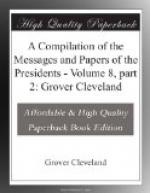The surplus stores, with the boats and camp equipage, were stored there, and were afterwards transferred to the parties of the two other commissioners.
A map of the operations of this division was placed on file in the State Department on the 27th December.
The distance surveyed along Green River from its mouth to the portage is 57 miles, the length of the portage 5-1/2 miles, the distance measured in exploration of the remaining portion of the boundary claimed by the United States 61-1/2 miles, making in all 124 miles.
II.
The parties under the direction of A. Talcott entered upon their field duties about the middle of September, and completed that branch of the service by the 5th of November.
During that period the following rivers and streams were surveyed:
1. The “main St. John River” from the mouth of the “Alleguash” to the Forks.
2. The “Southwest Branch” to its source at the Metjarmette portage.
3. The “South Branch,” or “Wool-as-ta-qua-guam,” to 5 miles above Bakers Lake and near to the exploring line of 1841 along the highlands claimed by Great Britain.
4. The “West Branch,” or “Mat-ta-wa-quam,” to its source in the highlands.
5. The “Northwest Branch” to its source in the highlands.
6. The “Big Black River,” or “Chim-pas-a-ooc-ten,” to its source.
7. The “Little Black River,” or “Pas-a-ooc-ten.”
8. The “Chim-mem-ti-cook River” as far as navigable.
The character of all these streams is the same—slack water of moderate depth alternating with rapids. They can never be navigated by anything larger than a bateau.
The method of survey was to trace the course of each stream by compass, estimating distances by the eye, or by pacing when the nature of the margin of the river would permit.
The average distance coursed per day was about 9 miles, and at the camps formed at night astronomical observations north and south of the zenith were made to determine their position in latitude, and observations for the local time to ascertain their differences of longitude.
Meridian observations of the sun were also made at a point intermediate to the camps whenever they could be obtained.
Thirty-three of these points have been used in the correction of the paced and estimated distances.
Tables exhibiting these observations, their calculation and results, will accompany the detailed maps.
With a view to facilitate the operations of the joint commission it was conceived to be important that the intersection of the parallel of 46 deg. 25’ with the Southwest Branch should be ascertained, as also the point on the Northwest Branch (10 miles from the main St. John) where the boundary line from the outlet of Lake Pohenagamook intersects the said branch.
It is believed that these points are projected on the map which accompanies this report so near to their true position that the line indicating the boundary as drawn on the map may be considered to substantially exhibit the division of territory as effected by the late treaty.




